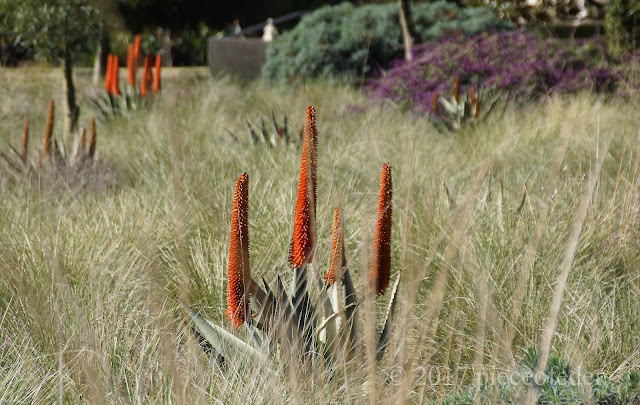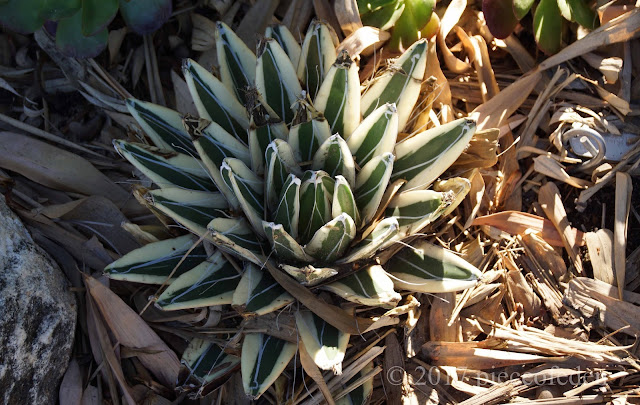We visited the Huntington just before Christmas to see what Aloes were in bloom. Aloe ferox above, Aloe barberae and Aloe 'Erik The Red' (?) below
Several of the epic old Aloe barberae have been recently removed due to age and rot. There are one or two left, along with newly planted young specimens.
A surviving Aloe barberae
I wish I'd bought Aloe sabea when I saw it for sale. Have not seen it available since. It's like a super model version of thraskii.
A large group of 'David Verity' near the desert conservatory always puts on a spectacular show
Aloe rubroviolacea is blooming again. It was blooming last year at this time, and in spring, and in summer as well.
Rupestris? The Western Scrub Jay was pecking at the flowers--picking out insects, or nectar?
This was an interesting cross: vaombe x barberae. There's a small flower stalk emerging.
Somewhat of an autumnal look due to the Sycamores.
Aloe aculeata. This was blooming at rather a small size, so perhaps I won't be waiting a decade for my seedling to bloom.
Aloe elegans, yellow form. Someone was isolating a flower for hybridization and seed collection.
Ah, there it is, a plant I've wondered about since it vanished from the garden some months ago. This Aloe suzannae was once falling over into a pathway. Last visit it was suddenly gone. They replanted it here.
Here's another suzannae, and it is blooming! This species is a slow grower and reluctant bloomer, so this is an event. I wonder if they will bag up some flowers to collect pure seed.
None of suzannae's flowers were yet open.
Aloe suzannae is endemic to Madagascar. Madagascar is also home to Euphorbia enterophora. The Huntington's is apparently a mere start, judging by the plant in the link. Appears to be a plant snob's version of E. turucalli--very cool!
Well, enough for now. I did spot this gorgeousness near the place where a giant Aloe barberae had been removed. Wowza. Anyone could have stepped on it without noticing.
There are treasures everywhere, if we care to look.
Several of the epic old Aloe barberae have been recently removed due to age and rot. There are one or two left, along with newly planted young specimens.
A surviving Aloe barberae
I wish I'd bought Aloe sabea when I saw it for sale. Have not seen it available since. It's like a super model version of thraskii.
A large group of 'David Verity' near the desert conservatory always puts on a spectacular show
Aloe rubroviolacea is blooming again. It was blooming last year at this time, and in spring, and in summer as well.
Rupestris? The Western Scrub Jay was pecking at the flowers--picking out insects, or nectar?
This was an interesting cross: vaombe x barberae. There's a small flower stalk emerging.
Somewhat of an autumnal look due to the Sycamores.
Aloe aculeata. This was blooming at rather a small size, so perhaps I won't be waiting a decade for my seedling to bloom.
Aloe elegans, yellow form. Someone was isolating a flower for hybridization and seed collection.
Ah, there it is, a plant I've wondered about since it vanished from the garden some months ago. This Aloe suzannae was once falling over into a pathway. Last visit it was suddenly gone. They replanted it here.
Here's another suzannae, and it is blooming! This species is a slow grower and reluctant bloomer, so this is an event. I wonder if they will bag up some flowers to collect pure seed.
None of suzannae's flowers were yet open.
Aloe suzannae is endemic to Madagascar. Madagascar is also home to Euphorbia enterophora. The Huntington's is apparently a mere start, judging by the plant in the link. Appears to be a plant snob's version of E. turucalli--very cool!
Well, enough for now. I did spot this gorgeousness near the place where a giant Aloe barberae had been removed. Wowza. Anyone could have stepped on it without noticing.
There are treasures everywhere, if we care to look.



















Treasures indeed! Just the dose of SoCal we in the frozen north need right now! Thanks.
ReplyDeleteStay warm! I guess your area has a polar vortex on the way again?
DeleteSo beautiful! I remember seeing that yellow aloe elegans with its bags also. I wonder what they are hybridizing it with?
ReplyDeleteThere were some little tags and dates with info on the bag, but I don't remember what they said.
DeleteFurther evidence that I need to add some of the larger aloe specimens to my south-side succulent garden - it could use more jolts of orange and red during the winter months.
ReplyDeleteAnd the hummers love them! A. vaombe has brilliant red flowers...
DeleteOh the Huntington, such incomparable beauty! Lucky you to visit often enough to know when a plant has disappeared or been moved.
ReplyDeleteIt is really helpful to watch the plants grow and either thrive, or not. Some become like friends that you look forward to seeing every visit. :)
DeleteThose fiery pokers do my heart good!
ReplyDeleteHopefully not literally! ;)
DeleteWow, I can't believe they planted that white-variegated Agave victoria-reginae where people can step on it so easily. It's a real treasure!
ReplyDeleteThanks for another wonderful Huntington update! Without you, I wouldn't know what's in bloom there. Your our eyes and ears!
Yes, that surprised me. IMO it belongs in the Desert Conservatory with other rare gems.
DeleteGlad you enjoy the Huntington shots!
I could have sworn I saw an A. victoria-reginae just like it *IN* the Desert Conservatory. But they probably have multiples.
DeleteMultiples? Ahhhhhhgggggggggrrrrrhhh!
DeleteI always enjoy your visits to the Huntington Gardens. One day, I hope to get a chance to visit it myself, but for now, admire it vicariously through your eyes. That Euphorbia enterophora is a real oddball. Wonder how long it will take to grow as big as the one in Madagascar...?
ReplyDelete